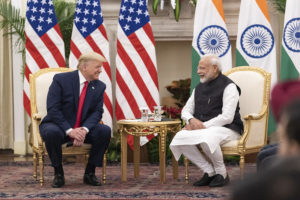
President Donald J. Trump and Indian Prime Minister Narendra Modi are joined by their delegations during bilateral discussions Tuesday, Feb. 25, 2020, at Hyderabad House in New Delhi. (Official White House Photo by Shealah Craighead)
UPDATE 4.20.23: Admiral John Christopher Aquilino recently told a hearing on Indo-Pacific National Security Challenges that the United States and India face the same adversary in the region, China. WION’s Abhinav Singh reports:
The US is providing assistance to India to counter its adversary China on the border areas and also develop defence industrial base, a top American commander has said, adding that Washington and New Delhi faced the same security challenge from Beijing in the strategically important Indo-Pacific region.
The statements were made by Admiral John Christopher Aquilino, commander of the US Indo-Pacific Command during a hearing on Indo-Pacific National Security Challenges conducted by the House Armed Services Committee.
“We value our partnership with India, and we’ve been increasing it and doing a lot more, over time. They have the same security challenge, primary security challenger that we do, and it’s real on their northern border. Two skirmishes now in over the past nine or 10 months on that border, as they continue to get pressurised by the PRC for border gains,” said Aquilino.
The US admiral was responding to a question from Indian- American Congressman Ro Khanna who said the relationship between India and China had soured with the latter treating other countries as ‘junior’ partners.
“I would like you to reflect on the importance of the relationship – postcolonialism India and China had a relationship to emerge as the Asian voice. But that relationship now has really soured with a concern that there should not be a hegemon in Asia and that China is treating other countries as junior partners,” said Khanna.
Aquilino answered that US and India were on the same page when it came to the China threat.
“We also have the desire to operate together, based on the world’s largest democracy. We have common values, and we also have people-to-people ties for a number of years. I met with General (Anil) Chauhan, my counterpart, at the Raisina Dialogue not long ago. I’ve been to India five times now in the past two years.”
UPDATE 7.28.22: In a white paper that has gone little noticed in Western media, Japan has emphasized the importance of Quad Cooperation in the face of potential Chinese aggression. Amrita Nayak Dutta of News18.com reports:
Defense of Japan 2022, made public last week, said the Indo-Pacific region, in which Japan is located, faces various security challenges and has been significantly affected by the recent changes to the global balance of power fuelled by the ongoing Russia-Ukraine war.
The paper particularly lists the growing tensions between the US and China in Taiwan and the South China Sea, the divide in the Korean Peninsula, and China’s “unilateral attempts” to change the status quo by coercion near the Senkaku Islands as well as the unilateral changes it is making to the status quo in the South China Sea among the different security challenges facing the Indo-Pacific region.
The paper states that the Indo-Pacific region is the core of the world’s vitality, which is home to half the world’s population and major sea lanes pass through the region.
“The ‘Free and Open Indo-Pacific’ (FOIP) vision is based on the concept of ensuring the peace and prosperity of the entire Indo-Pacific region and consequently the world by realising a free and open order based on the rule of law in the region,” it states.
It adds that the FOIP is an inclusive vision and any country can cooperate as long as it endorses the concept.
Meanwhile, according to Global Times, China’s ministry of defence said on Tuesday Japan’s white paper “disregards facts and is biased against China. China asks Japan to face up to and reflect on the history of its aggression, and stops confusing the international community under the guise of a victim”.
Originally posted on February 28, 2022.
While the world fixates on the current crisis in Ukraine, former Chairman of the Joint Chiefs of Staff, Gen. Mike Mullen, is visiting Taiwan to show support for its independence in the face of Chinese aggression. The biggest, and perhaps most important, initiative by the United States in its continued “pivot to Asia,” is the development of an organizational structure known as the Quad. The Quad is a loose alliance made up of four countries that include, the United States, India, Japan, and Australia. These are arguably the most powerful countries in the area aside from China. In Spectator World, Brahma Chellaney explains the growing bonds between the United States and India, writing:
The world’s center of gravity is shifting to the Indo-Pacific. The new global order will be shaped by developments in a sprawling region where interstate rivalries and tensions are sharpening geopolitical risks. Building a stable balance of power in the Indo-Pacific has become more important than ever, but China’s territorial and maritime revisionism, and its heavy-handed use of economic and military power, are causing instability and undercutting international norms.
Against this background, the expanding strategic partnership between the world’s most powerful and most populous democracies — the United States and India — has become pivotal to equilibrium in the Indo-Pacific. With India’s closer integration, the four-nation Quad — Australia, India, Japan and the US — is blossoming as a strategic coalition of the leading Indo-Pacific democracies.
The Quad is central to the US’s “free and open Indo-Pacific” strategy. As American preeminence erodes, the US must augment its power with that of allies and partners. China’s foreign minister Wang Yi famously mocked the Quad in 2018 as a “headline-grabbing idea” that will dissipate “like the sea foam in the Pacific or Indian Ocean.” Instead, and thanks to China’s expansionist policies, the Quad continues to gain strength — despite the new, US-initiated AUKUS alliance with Australia and Britain. The US cannot build an Asian power equilibrium without India, Japan and Australia — and they cannot build it without the US.
Today, the US is also close to achieving a long-sought goal: a “soft alliance” with India that needs no treaty. The US has already emerged as the largest arms seller to India, leaving its traditional supplier, Russia, far behind. US defense transactions with India went from near zero in 2008 to over $20 billion in 2020. Furthermore, India has signed the four “foundational” agreements that the US maintains with all its close defense partners. These accords range from providing reciprocal access to each other’s military facilities and securing military communications to sharing geospatial data from airborne and satellite sensors.
India, a founder and leader of the Nonaligned Movement that sought to chart a neutral course in the US-Soviet rivalry during the Cold War, now makes little mention of nonalignment. Instead, it is multi-aligned and building close partnerships with democratic powers from Asia to Europe. India now holds more annual military exercises with America than any other country.
The main driver of the growing US-India strategic collaboration is China’s neo-imperial expansionism. President Xi Jinping believes that China has a narrow window of strategic opportunity to modify the international order in its favor before it confronts a demographic crisis, stalled economic growth and an unfavorable global environment. Accordingly, Xi has shown an increasing appetite for taking major risks.
American and Indian strategic priorities regarding China are, however, not the same. The US has never considered fighting a land war against China. The primary American objective is non-military: to counter China’s geopolitical, economic and ideological challenges. By contrast, China poses a pressing military challenge for India. The spotlight on the Chinese threats against Taiwan has helped obscure China’s more serious military confrontation with India along the long Himalayan frontier — a confrontation that is still raging.
The US and India, however, are united by other shared strategic interests. These include the rule of law, respect for territorial integrity and sovereignty, freedom of navigation, peaceful dispute resolution and a rules-based Indo-Pacific free of coercion. The biggest challenge to all these principles comes from China.
In May 2020, a shocked India discovered that China had stealthily encroached on several key border areas in the northernmost Indian territory of Ladakh. The discovery led to the first deadly Chinese-Indian military clashes in the Himalayas since 1975, including China’s first combat deaths in over four decades. The Indian and Chinese militaries remain locked in multiple standoffs, and the steadily increasing introduction of new weapons and troops by both sides has amplified the risk of renewed border skirmishing, if not outright war. Xi has picked a border fight with India that China cannot win. A war between these two nuclear- armed demographic giants is likely to end in a bloody stalemate with heavy losses on both sides. This is not the only instance in which Xi’s aggressive policies have proved to be counterproductive.
For India, China’s territorial aggression proves the importance of building close strategic collaboration with the US and likeminded powers. India today seems more determined than ever to frustrate China’s ambition to achieve Asian hegemony. By locking horns with China in tense military standoffs despite the risk of a full-scale war, India has openly challenged Chinese capability and power in a way no other power has done in this century. Since 2020, when India let Australia join the annual Exercise Malabar war games with the American, Japanese and Indian navies, the Quad has possessed a platform for an annual military exercise involving all its members.
Xi must now also contend with the strengthening US-India relationship. In a pivot to Asia that much of the US media either ignored or derided, the Trump administration gave India pride of place in its Indo-Pacific strategy. It also instituted fundamental shifts in US policies on China and Pakistan, two close allies whose strengthening strategic axis in southern Asia imposes high security costs on India, including raising the specter of a two-front war. Trump reversed the forty-five-year US policy of aiding China’s rise; with bipartisan support, he designated China as a strategic rival and threat. His administration also cut off security aid to Pakistan for not severing its ties with terrorist groups.
If you’re willing to fight for Main Street America, click here to sign up for the Richardcyoung.com free weekly email.




